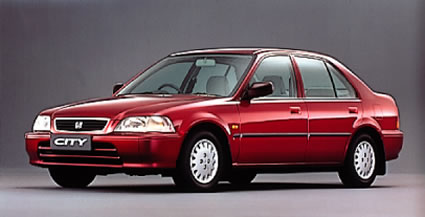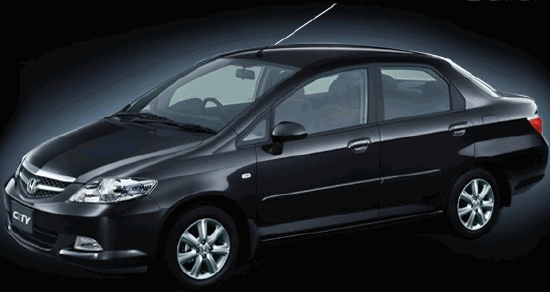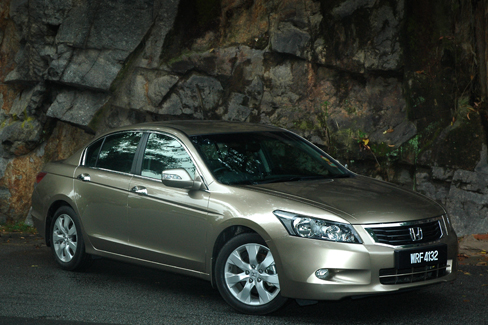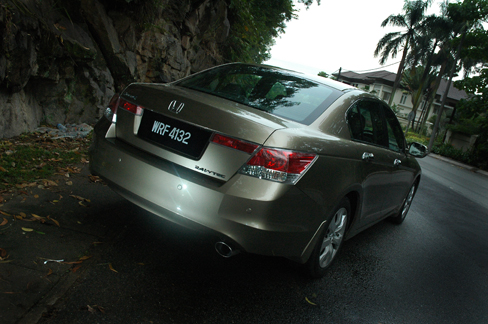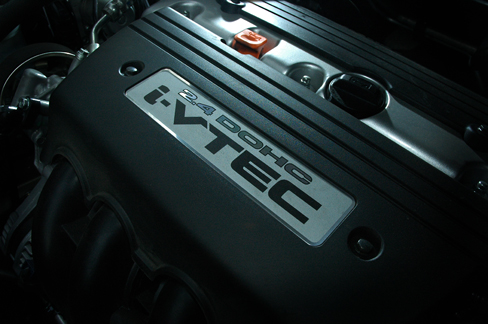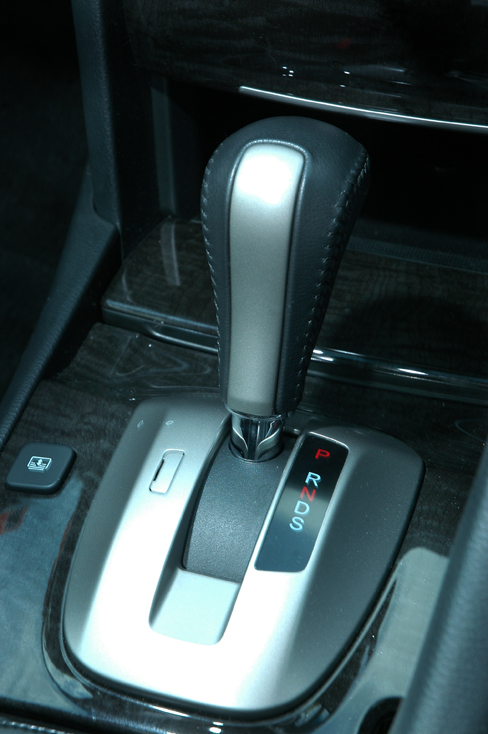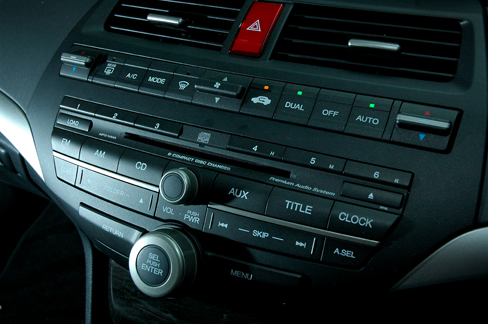With all the hoo-haa surrounding the City’s launch on 18 Dec, the Honda showrooms all over the country braced themselves for what was going to be an extremely packed weekend, as car buffs and buyers flock to check the new car out. Traveling in disguise, I headed to the premises of Tenaga Setia Resources Sdn Bhd, better known as the ‘Honda Jalan 222 showroom’.
It is one of the more famous navigational landmarks around Petaling Jaya, and being prominently located right alongside one of the busiest roads of the city. As such, it’s one of the first Honda showrooms to cross people’s minds. This, together with the limited amount of space in and around its premises leads to cars of visitors parked by the road side becoming traffic hazards.
“You turn at Jalan 222, and then you see the Honda showroom there, bla bla bla…”
I arrived at the showroom at 3:30pm on Sunday, and it still had a very healthy crowd. There were two display cars in the showroom, both being the Grade S variant. It was not the smartest setup, as this deprived visitors of the opportunity to compare both spec variants live. As a result, the salespeople were seen escorting people outside to view the Grade E test car between test drives. The test car was also decked in the Modulo bodykit and sport rims, that would add over RM7k to the retail price – think properly before ticking these options!
Plenty of visitors even at 3:30pm. Had to wait for over an hour for my test drive.
A customer gets ready to take the City for a spin.
Due to the sheer number of customers present, it was over an hour before I got a chance to take the car out for a quick spin. This gave me plenty of time to examine the car in much closer detail, observe the actions of other visitors and also put some of the salespeople to test with their product knowledge.
Having pored through the entire press and technical release kit I picked up from the launch, I also have a reasonable degree of familiarity with the City’s features and technical bits. However, most people (me included) still have no idea of what the gear ratios are, as this piece of information was not available anywhere in the sales catalogs or press kits.
I am not looking for accuracy of each ratio to four decimal places, but I was curious whether the fourth gear was a 1.000 or an overdrive ratio. When quizzed about this, the salesperson I asked told me that there was ‘no overdrive, only got paddle shift.’ Well, I saw no point proceeding further, and I was none the wiser.
While the salespeople were not expecting to face someone secretly armed with info from Honda’s press release, they seemed more than ready to face the rest of the masses, as I saw all of them talking customers into nods. How many of those nods translated into bookings, only they would know, but we could see the Malaysian car inspection culture at its meticulous best – anything that can move was tested to its full range of motion. Every panel was felt to its entire length. The doors, and the boot were opened and closed more times in that one day than what most cars get in a year.
“Engine powerful or not? Save petrol or not?”
With the brighter lighting in the showroom compared to during the launch at Mandarin Oriental, I was able to get a better look at some of the smaller things in the car. The gadget-happy folks will be glad to know that their iPODs will dock with the audio units of both variants. And, as highlighted in the brochures, there were plenty of storage spaces for small objects, though the centre console box is shockingly tiny, being definitely smaller than even those found in a Wira.
iPOD dock available even in Grade S trim.
I had a bigger centre console box in my Wira.
In what was definitely the most shocking omission from a car’s spec sheet of all time, good old UMW Toyota actually specified the Vios J without intermittent wipers. Thankfully, Honda did not go down that route in the cost-cutting stakes, and kindly included intermittent wipers as standard. However, with the Grade S, you don’t get variable speed adjustment, and you have a stalk that so obviously blanked out that feature.
You at least get intermittent wipers, but no variable speed though.
Fortunately, for the rest of the car, there didn’t appear to be many obvious cost-cutting measures that can be deemed unreasonable at this part of the market. However, the rear shelf panel does appear to be rather cheap being made of a rough grade of hard plastic, and for the Grade S, there was just empty space which made me wonder how much would the underseat tray specified for the Grade E variant have cost.
Honda claimed that they have shifted the pedals of the new City 15mm to the right from the outgoing one, though I am not sure why they even bothered. The reason for this shift was to accomodate a footrest for the left foot, but having did all the hardwork redesigning the geometry of the linkages, all Honda did was slap a rubber piece which almost blends into the floor. It really didn’t feel like it was even there.
For the rest of the interior, I have few complaints, though it seems that the rear headroom has been reduced, with my head now just touching the roof when sitting upright. Reduced practicality aside, this is still a well-designed and well-built interior – definitely superior in quality and equipment compared to the Toyota Vios even in the RM89k 1.5S trim.
In case you didn’t know, the new City’s bootspace increased from the outgoing model by a total of six litres, bringing it to 506 litres of bootspace. Access to those 506 litres is facilitated by opening a bootlid that has an inverted Y-shape shutline, and a C-shaped type hinge. In order to avert interference between the bootlid and taillights when opening, the geometry of the bootlid’s opening motion was engineered to come slightly outwards before going up. The C-shaped hinges also do not intrude too much into the bootspace, which is a problem I trust Proton Waja owners will definitely be familiar with.
“Upside-down Y” shutline consumed many engineering hours.
Finally, time to hit the road. As I reversed the car out of the parking spot, and maneuvered to exit the showroom premises, I immediately noticed that the steering is weightier and had more feel than the previous City. Thumbs up to Honda for addressing that one. I remember when testing the old City, I almost ‘over-steered’ the car onto the kerb, being not used to the degree of assist from the electric power steering (EPS).
The new 1.5 i-VTEC engine packs sufficient punch when pressed. The engine does roar a bit past 4,000rpm, which might not be to everyone’s taste, though it’s not as gruff as, say, the Waja/Lancer 4G18. The response of the paddle shifts were quick enough under hard acceleration, with only a very minor delay in shifting time. There wasn’t sufficient time to draw a proper conclusion, but the powertrain’s performance is adequate for most city and even PLUS highway driving conditions.
Honda went out of its way to build a sportier and more energetic image for the new City – evident in repeated use of words such as ’style’, ‘excitement’, and ‘dynamic’ in the whole launch affair. There was a lot of enthusiasm and energy emanating from the Honda camp on this product.
On style and image alone, the new City is definitely a leaps-and-bounds improvement over the old. The design language revolves around what Honda terms as the “Arrowshot Form”, in which the City’s overall profile is supposedly reminiscent of an archer ready to fire his bow.
Where the outgoing City was offered with the choice of two 1.5-litre engines coupled with a CVT, the new one comes with only one powertrain option: a 1.5-litre i-VTEC engine with a conventional 5-speed automatic transmission. No consumption figures are available at the moment, but one can expect a slight increase compared to the old model at the very least.
For the interior, the engineers has also decided to forego some of the renowned practicality of the old model and infuse a bit more style into the cabin. The dash no longer features dual gloveboxes to start with, and the omission of Ultra-Seats was most unfortunate, being replaced with a conventional 60:40 split-folding rear seat back that could also recline.
Interior sacrifices a little on practicality for style.
Trim Level & Prices
The new City comes available with two trim levels, priced at RM5,000 apart from each other with the Grade S going for RM84,980 and the Grade E going for RM89,980. Mechanically identical, the two variants are also not far apart in terms of specification levels, with the cheaper Grade S also having twin airbags and rear disc brakes as standard.
Differentiating them are items such as rim sizes, fog lights, side-mirror signal lights, chrome finish exhausts, transmission paddle shift, steering wheel audio control, leather finishing for the steering and gear knob and auto retract door mirrors. A big miss for those opting the Grade S variant will be the split-folding rear seats, as they will be getting fixed rear seat backs. The extra RM5k Honda asks for the Grade E isn’t a lot, but the Grade S is pretty much all the car you need.
HM has also made available to customers the option of specifying their cars with Modulo accessories designed specially for the City. The accessories can be ordered individually, or lumped together into a RM4,750 full bodykit package. Not being a fan of non-performance enhancing parts, it’s not an option box that I’m too keen to tick.
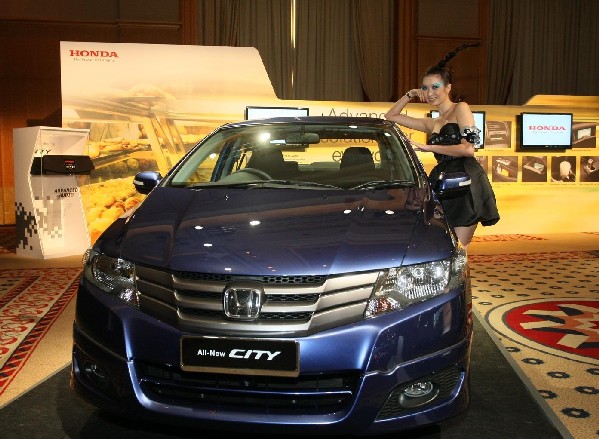
City specified with RM4,750 Modulo bodykit.
The 16″ Modulo rims, available only for the Grade E is a nice alternative to the stock rims, but rather pricey at RM2,480. The good news of course, is that all these (rather pricey) little goodies are covered by the car’s standard warranty.
Concept & Philosophy
Throughout the whole launch event, those present were fed with a diet of words coated with a high dose of enthusiasm (some of them a little over the top). Indeed, there was no mistaking the fact that Honda went out of its way in its attempt to create a strong enthusiastic appeal for the new City.
According to Mr Takeshi Nakamura, Chief Engineer of Honda R&D Co. Ltd., “We identified key words that capture the ideas of visual appeal, performance and comfort. The expression of a ’strong’ appearance is especially essential. From there, we created the concept of Advanced Proud Sedan.”
Powerful words there, Nakamura-san. Three important cornerstones were named in the design brief of the City, they were stylish design, smart package, and smooth driving. The goal was to create a car that had enthusiastic, performance and practical appeal all-in-one. Laudable goals indeed, but a tough one to pull off.
The philosophy behind the new City – a brief too big to fill?
Honda got the stylish design part right, and they got it very right. Inside and out the new City has far greater presence and aura than the outgoing model, but it isn’t as smart a package with the removal of quite a few key features that defined its predecessor. The smooth driving part will be investigated in greater detail over a test drive.
Exterior Design
Compared to the bulbous and often criticized shape of the outgoing City, the new City goes back to far more conventional sedan proportions and is peppered with more aggressive and advanced details.
Being the first City marketed in Europe, it’s not surprising that the front end borrows heavy design cues from the European version Civic hatch and Accord Euro. This gives the City a far more distinctive and futuristic look from the front, with the headlights and grille forming a one-piece illusion.
The side profile is where the City looks its best. It now looks like Honda really designed the City from ground up as a car on its own rather than apparently slapping a huge boot on the Jazz for the previous City.
The rear end does not look too exciting, despite Honda’s description of it being the ‘unforgettable rear view’. In fact, when viewed from the rear three-quarter angle with a lowered perspective, it looks rather top heavy. How Honda feels that this design look suggests ‘greater stability’ is rather beyond me.
Hardly the best view of the car.
It may not look much, but the design of the bootlid probably consumed far greater engineering hours than we would imagine, thanks to the “upside down Y-shape” (Honda’s words, and it took me a while to figure it out too) cut-off line between the lid and the tail lamps. In order to avoid any interference with the tail lights when opening, the hinges and opening motion of the bootlid had to be engineered in precise detail.
For the wheels Honda specified two different and distinctive rim designs to differentiate the two model variants. The simpler 15 x 5.5J rims of the Grade S actually look better than the more elaborate 16 x 6J versions equipped for the Grade E. Oddly however, the tyre sizes specified are not of the commonly available variants: 175/65 R15 and 185/55 R16. Good luck when hunting for replacements.

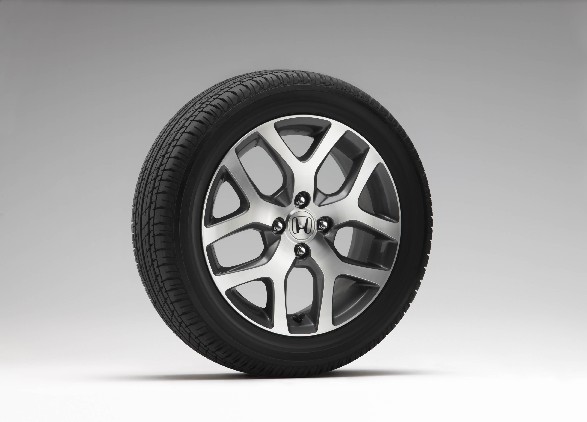
Unusual tyre sizes: Grade S gets 15″ rims shod in 175/65 tyres, while Grade E gets 16″ rims shod in 185/55 tyres. This writer prefers simpler rim design of 15″ set.
Interior
The interior of the new City is created based on the concept of a ‘Cool Lounge‘, which supposedly creates a (warning: marketing jargon alert) ‘relaxing atmosphere with strength and character.’
Honda also claims that ‘colours and materials were carefully selected to complete a cabin that instantly relaxes and cools down passengers as soon as they get into the car.’ Well, at least we know they’ve done their marketing survey as far as Malaysia is concerned.
The outgoing City trumped all competitors from its class and beyond in its interior packaging. That Honda managed to fit a hugely spacious cabin into a rather small body was amazing enough, it also incorporated many ingenious features and touches that demonstrated amazing thoughtfulness on the part of its engineers.
However, inline with the new City’s overall more aggressive design stance, some of the clever practicalities of the previous car were jettisoned in the name of style. Two gloveboxes were reduced to one, and the Ultra-Seats, a defining feature of the previous City were dropped.
Dash now features only 1 glovebox. Steering wheel with tilt & telescopic adjustment borrowed from Civic.
The centre console is given a brushed metal finish and features an integrated audio head unit with three big dials to control the air-conditioning unit. It’s plain looking, but being simple & uncluttered it doesn’t take a genius to operate, a welcome contrast to the confusing buttons galore on the Accord I tested last weekend.
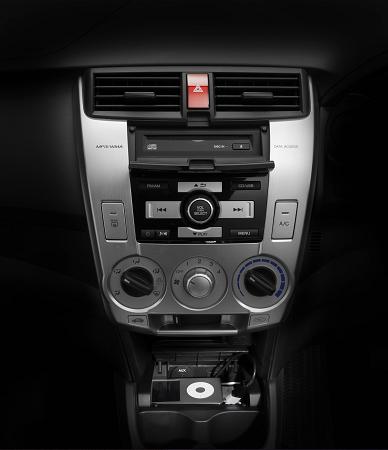
Centre console with iPOD dock.
The instrument cluster consists of three gauges: the speedometer in the centre flanked by the tachometer and the fuel gauge. Like in the previous City, Honda has chosen not to include a water temperature gauge, which is an unacceptable omission in my view. The digital trip computer display shows the odometer, tripmeter, fuel consumption indicator and range indicator. In surely what was unrestrained overstatement, Honda proclaims it as an ‘Advanced Meter Design‘. You decide.
In place of the sorely-missed Ultra-Seats are the 60:40 split-folding rear seatbacks that can also recline. There is also a huge underseat tray below the rear seats to compensate for the reduced storage capacity. However, neither of these items will be available with the Grade S trim, which makes do with fixed rear seats.

60:40 split-folding and reclining rear seats
Under-seat tray to stash your… umbrellas.
During the press conference, it was explained that the Ultra-Seats were omitted because it compromised on rear occupant comfort and that the 60:40 folding seats were adequate compensation for their deletion. Surprisingly though, Honda didn’t even bother to engineer the folding seats to create a flat-floor with the boot. The reclining seatbacks are a nice novelty, but I’d take the Ultra-Seats any day.
Fortunately, Honda still left many other thoughtful touches in the cabin in form of tiny storage areas all over the car. There are a total of three cupholders (plus two in the centre armrest, available only for Grade S), the centre console box, a little slot beneath the driver air-con vent, front seat pockets and door pockets each side still ensuring ample storage space for loose items.
A little piece of irony, I actually hitched a ride from a friend driving a 1996 Honda City to the launch of this new City. While in her car, a little thought crossed my mind when I was holding my phone on my left hand, resting on the door armrestwith the phone over the position of the power window switch, I thought it would be nice if there was a cubby hole there just to fit my phone. Hence, I was both amazed and amused when I found that the new City does indeed have a little slot just behind the passenger’s power window switch just big enough for a handphone.
The Powertrain
The City’s drivetrain, according to Honda’s engineers, is engineered to provide a ‘gutsy & relaxing’ feel. The claim is that the City is going to deliver responsive performance when prodded and yet cruise in comfort. Once again, big words – but the numbers supporting them are encouraging.
Under the hood is a 1,497cc 16-valve SOHC i-VTEC engine producing 120PS @ 6,600rpm and 145Nm @ 4,800rpm. Putting that figure into perspective, the outgoing City VTEC’s engine produces 110PS @ 5,800rpm and 143Nm @ 4,800rpm. A more telling comparison is that Proton’s 1.6 Campro CPS powerplant is only slightly more powerful being rated at 125bhp and 150Nm.
(Note: PS stands for Pferdestarke, which is the German term for horsepower.)
Besides being armed with Honda’s i-VTEC system, the engine also features a host of technological improvements such as drive-by-wire technology, high-strength light weight con-rods and rocker arms, patterned piston coating and an auto tensioner to regulate belt tension.
All the abovementioned technology, and others, help to chart out an impressive power and torque curve for the engine, ensuring a minimum 120Nm of torque available at all RPMs. A laughable claim is that a torque dip at 3,500rpm is engineered to engine’s character to deliver ’smoother driving performance’. I drive a Waja Campro, and I know for a fact that dips in the torque curve don’t contribute to smoother driving.
Power & Torque Curve compared to old City. A minimum of 120Nm of torque available across the range. Torque dip at 3,500rpm ’smoothens driving performance’. Beat that.
For the Malaysian market, Honda is specifying the City with only one transmission, a 5-speed automatic. While still a class leading specification, it is still unfortunate that we will be missing out on the 5-speed manual version or the 6-speed i-SHIFT automated manual transmission that is available in Europe.
Buyers of the Grade S variant will get a straight forward [P R N D D3 2 1] gear interface. There is no OD OFF button to block off only the fifth gear, with drivers only having the option of manually selecting the first three gears. If you opt for the Grade E spec, your gear interface is a simpler [P R N D S], and you get paddle shifters to enable you to manually select each of the five gears.
I used to be a big fan of semi-auto transmissions, but the truth is, after a while the novelty of these things wear off, because at the heart of it, it’s still an auto. Nonetheless, it’s still useful in an auto that the driver has the option of manually selecting any gear of his/her choice, which is why in the case of the City, the paddle shifters would actually be useful.
5-speed auto standard. Paddle shifters available for Grade E only.
Chassis
Honda claims to have successfully increased the rigidity of the City’s chassis compared to the outgoing model while maintaining the same overall weight. It incorporates the best features of Honda’s advanced chassis engineering such as G-Force Control Technology(G-CON) and Advanced Compatibility Engineering (ACE) – features which scored the Accord Euro a five-star EuroNCAP rating.
Like its predecessor, the City does not get independent suspension all-round. It’s the same old story of the MacPherson struts up front and a torsion beam rear axle – not something boast too loud about to your friends who drive Proton Wiras and Personas with multi-link rear suspension.
The electric power steering system also stays, but Honda claims that they have reworked the system to give it a more ’steady and direct steering feel.’ Whatever they mean by that, it had better be a substantial improvement over the dead-feeling and over-assisted steering of the outgoing City.
Stopping power is provided by four disc brakes supplemented by ABS, EBD and Brake Assist (BA), which to Honda’s enormous credit, are all standard for both trim variants. Should that fail to stop you in time for a collision, twin airbags (standard on both variants) will deploy to increase your chances of survival considerably.
Finally…
Without a proper test drive, it is impossible and inappropriate to give a car a proper verdict. The specs sheet give a positive first impression, and the reported 3,000 bookings received by Honda Malaysia is testimonial to Honda’s badge credibility.
Overall, the new City looks like a far more exciting product than the outgoing car, despite dropping a few of the old car’s unique selling points – the CVT and Ultra-Seats being notable omissions. Where the old car was marketed purely on its clever and practical features, the new one sacrifices some of that in the name of style and desirability.
On paper alone, the new City remains a very competitive, and very capable car. Honda set itself a target to come up with a car to be all of practical, sporty and stylish at the same time. The boys at Honda are obviously very proud of it, but I am wondering if they have given the City too big a brief to fill.
Only a test drive will tell.
One of the most eagerly anticipated car launches of 2008, the Honda City was finally launched for the Malaysian market at Mandarin Oriental, KL on 18 Oct.
With dozens of cameras taking aim, the new City was driven onto the stage by Mr. Atsushi Fujimoto, Managing Director & Chief Executive Officer of Honda Malaysia. With him in the car were Mr. Takeshi Nakamura, Chief Engineer & Large Project Leader, Honda R&D Co. Ltd. at the front seat, and Honda Malaysia chiefs at the back seat: En. Azman Bin Idris (President & COO) and Mr. Ikuo Kanazawa (Vice President).
Powered by a 1.5-litre i-VTEC engine, the City is available in two trim levels, both featuring a 5-speed automatic transmission in place of the outgoing model’s CVT.
The entry-level Grade S is priced at RM84,980, while the Grade E version would cost potential buyers an extra RM5k. Customers also have the option of specifying their City with Modulo accessories (read: skirts and spoilers) that adds RM4,750 to their purchase price.
Click here to read YS Khong’s report of the launch in the AW main pages. Scroll down for more pictures from the launch.
An eagerly anticipating crowd signing up to get in.
The tension is rising, photographers eagerly await the car’s arrival.
Honda chiefs stepping out of the car…
While the rest of the media jostles for a good picture, I took the easy way out…
Fujimoto-san and Nakamura-san… for posterity.
1,497cc i-VTEC powerplant produces 120PS @ 6,600rpm and 145Nm @ 4,800rpm sent to front wheels via a conventional 5-speed torque converter type auto transmission. Grade E gets paddle shifts for manual override.
Rear discs standard even on cheaper Grade S
No independent rear suspension though.
Full-sized cutaway of the City.
Compared to outgoing City, new car’s interior is far more stylish, but significantly less practical.
Underseat tray somewhat compensates for omission of Ultra-Seats
Twin airbags are standard for both trim levels. Interior now makes do with one glovebox.
This is a very thoughtful feature. I want to credit the engineer who thought of this.
60:40 split folding and reclining rear seats for Grade E.
Grade E(r) gets front fogs and 16″ rims, while Grade S(l) makes do with a simpler five-spoke 15-incher.
Grade E(r) has chrome finish on tailpipes. Grade S(l) gets a bare tailpipe, not unlike the Proton Persona B-Line.
It has become a running joke among my friends and family that I test drive cars with amazing regularity. Especially since signing up for a part-time blogger here in AW test driving cars has been almost a weekly affair for me, even though I am not part of any media test drive events.
Somehow, I seem to get wind of almost every test drive event in the Klang Valley and sometimes beyond – even the more obscure ones. Usually, I would just pick up the newspaper, spot an advertisement of a test drive event somewhere, trot off to take a few cars out for a joy ride and then share the tales.
However, there were times (fortunately rare) when I drove all the way to the advertised location only to find nothing, or worse, a roadshow with no test drives despite being offered in the advert. In fact, I almost thought it was another one of those days when I drove from PJ all the way to Jusco Bukit Tinggi in Klang for the final of four legs of the Honda Mobile Roadshow.
When I arrived, I drove around the entire Jusco premises without being able to spot the Honda tent. Having answered false test drive ads before, it seemed likely that I might return home empty-handed. Nevertheless, I took a chance and entered Jusco’s paying parking lot, and eventually spotted the tent deep inside the lot.
The Honda Mobile Roadshow kicked off on 14-16 Nov at the Kajang Stadium before going to Rawang on 21-23 Nov, The Store Sg Buloh on 28-30 Nov and finally on 12-14 Dec here at Jusco Bkt Tinggi. It was a peculiar choice by Honda Malaysia (HM) to situate all of its roadshows along the perimeter areas of the Klang Valley, with not even one conducted in more central places like Subang Jaya, Petaling Jaya, Bangsar or Sri Hartamas.
I usually advocate arriving early for test drive events and to be among the first customers along the queue so that you can get the best out of the experience. However, this time around, I needn’t have bothered, as there were no customers there even at 12pm – usually the peak hour for such weekend roadshows. That’s fine with me, as I also needn’t have to wait for my turn to take the Honda Civic Hybrid and the Honda Accord for a spin.
Honda Civic Hybrid
For all its green credentials, at RM162k, the Civic Hybrid does not make a convincing case. Even if it returns the astonishing consumption figure of 4.6l/100km it promised, it’s going to be a while before your savings recoup the RM34k premium over the 2.0 i-VTEC model.
However, thanks to the new taxing structure favouring hybrid cars, the Civic Hybrid’s price will be brought down to the region of RM125 – RM130k (HM has yet to finalize the price), and that makes it an interesting prospect, as it’s now placed squarely in the line of sight of standard Civic buyers.
Indeed, sitting in one, you’d be hard-pressed to tell the Civic Hybrid apart from the standard Civic. The interior is identical to the standard car, but that’s no issue, as far as I am concerned. It features the same two-tiered instrument cluster that houses the digital speedo in the upper tier and the tachometer with the gear lever indicator below.
Interior’s standard Honda Civic
Two tiered instrument cluster.
In this car, almost everything is designed with one purpose in mind – to save fuel. The 1.3-litre i-VTEC engine churns out 95hp @ 6,000rpm and 123Nm @ 4,600rpm, and it’s supported by a 20hp electric motor, dubbed Integrated Motor Assist (IMA) that is also good for 103Nm of torque from 0 to 1,160rpm.
Upon deceleration, the IMA charges up its power unit by converting the car’s kinetic energy to electric potential energy – which, at the same time, doubles as engine braking. However, when you bury your right foot into the drive-by-wire throttle (like how I was doing for a while), the two motors team up to provide a combined output of 115hp and 167Nm.
Sending those power and torque to the front wheels is a continuously variable transmission (CVT). Driving with a heavy throttle, the CVT kept the engine spinning at 4,000rpm while continuously varying the transmission ratios – building up speed, rather quickly, I might add.
That aside, it felt pretty much like driving a standard car, with only the little gauge at the instrument panel telling you whether the IMA is assisting the engine, or charging its batteries. The electric power steering was light to the turn, but not too light as I once experienced with a Honda City.
The brakes were most peculiar. The pedal’s travel felt to be no more than one and a half or two inches at most, but yet it was still relatively easy to modulate the vent disc / drum brake setup. At first, it felt more like a brake switch than a brake pedal, but then again, it was remarkably precise in responding to pedal modulation.
A pricetag of RM162k for this car is a dealbreaker, but, if as expected, when the Civic Hybrid is sold in the same price bracket as the 1.8 and 2.0 versions, then it becomes an alternative to consider. It looks and rides like your standard Civic, and if you don’t really need the extra performance of the higher capacity engines, I am sure you can do with the lower fuel consumption.
(+): The consumption, and how everything is directed at reducing it even more.
(-): Those set in the old ways of driving might not be able to accept this.
Verdict: You should consider this, if you have the budget at this range, but not needing the performance.
Honda Accord
Coming out of the Civic Hybrid my next target was the Honda Accord. Recently, I was in motortrader.com.my forum debating with a bunch of forummers about the validity of a comparo written in Autocar ASEAN between this car and the Mazda6 – which saw the Accord score a surprising victory.
Being a big fan of the Mazda, I was also stunned by the result, which saw the Honda not only beating the 6 in terms of price, space, practicality, and interior (things the Honda are actually expected to win) but also the ride, handling and performance – areas which the 6 is supposed to trump all the ‘boring’ Accords and Camrys.
I have never driven any of the Accords before, but this one truly deserved my attention, and, to be honest, I made it a personal mission to test this one, and see how it compares to the Mazda6 2.5 I tested not too long ago. So, I did the natural thing, and asked for the keys to the Accord.
However, my personal comparison of it against the 6 will have to wait, as I tested the top-of-the-range RM250k, 3.5 V6 variant – which plays on a totally different battlefield to the RM175k 2.5-litre Mazda6. Paying an extra RM78k over the 2.4 i-VTEC gets you a 3.5-litre SOHC V6 powerplant that produces 275hp @ 6,200rpm and 339Nm @ 5,000rpm.
3.5-litre V6 engine comes with cylinder deactivation function, but with all cylinders firing, it’s good for 275hp and 339Nm
In addition, the engine comes with what Honda calls Variable Cylinder Management (VCM), which selectively de-activates certain cylinders when the car is traveling on a reduced load i.e. cruising. The technology is so refined that it works imperceptibly, with only the green ‘ECO’ light in the instrument cluster indicating that it’s working its magic.
An impressive piece of technology that’s standard on the Accord is the Variable Gear Ratio Steering System (VGR). This isn’t so much as Honda’s answer to BMW’s Active Steering as Active Steering is BMW’s answer to VGR. There is a Honda press release for this technology that dates as far back as 1997, and it finally debuted with the S2000 in the year 2000.
The good news is that this little party piece (together with a few other things) is available standard for even the 2.0 and 2.4 models, more for the 2.4. This raises the question of whether if it’s worth spending an extra City’s worth of money for the 3.5 when the 2.4 is likely to do the job as well.
Your extra money are all going to an undoubtedly brilliant powerplant but little else. While 275hp and all the VCM trickery sounds wonderful on paper, they aren’t likely to make much of a difference in your daily down commutes. It gets worse when your friends driving the lower-end and very similar looking 2.0 and 2.4 start asking what’s the fuss about.
On the road, the powerful engine made light weight of the Accord’s massive bulk, but you’d expect it, given the price. Together with the VGR steering, it made the Accord feel lighter and more sprightly than its size suggest. Not knowing beforehand that the Accord has VGR can be quite disconcerting, as the steering was unbelievably light at low speeds.
The big question is now whether the top dog Accord is that good that Honda’s pricing it to encroach into German territory. While I believe it would leave the 2.0 for dead, I am not sure if the 2.4 can be that far behind that a customer would want to fork an extra RM78k for the 3.5. It doesn’t quite make sense.
Paying RM250k, you get the same dash as the RM142k 2.0 and RM172k 2.4 versions.
Look at those buttons… *pengsan*
(+): 3.5 V6 powerplant has bags of tricks. Variable gear steering as standard.
(-): Everything, except price, does not stand out against its weaker siblings.
Verdict: Buy the 2.4.
Back in September, the fifth generation Honda City was officially unveiled in Thailand, then later India. Now, the bosses in Honda Malaysia are gearing up for its launch over here in mid-December. They’re certainly stepping up the promotional blitz with adverts in the print media and prominently placed billboards.
It is one of the most anticipated car launches of 2008 in our market. Having allowed the outgoing City to soldier on against the new Toyota Vios for over a year, it’s time for Honda to respond. The new City will be wearing a nameplate that was introduced as early as 1981, but only made it to our shores in 1996.
1. First Generation (1982 – 1986)
The first generation City was launched as a three-door hatchback back in 1981. It was also available as a convertible and in Australia, was sold as a two-seater van. In some export markets, this Honda City was sold as the Honda Jazz. I distinctly remember a HK film that featured this car badged as the Jazz.
Engine tuning specialist company Mugen, made its name by developing a turbocharged variant of this car, dubbed the Honda City Turbo. The 1,237cc turbocharged engine, with all of Mugen’s best work, was good for 108hp @ 5,000rpm and 160Nm @ 3,000rpm, which is impressive even by today’s standards. It also featured an uprated suspension setup over the standard City, being independently sprung all-round.

First gen Honda City
(image from Wikipedia)
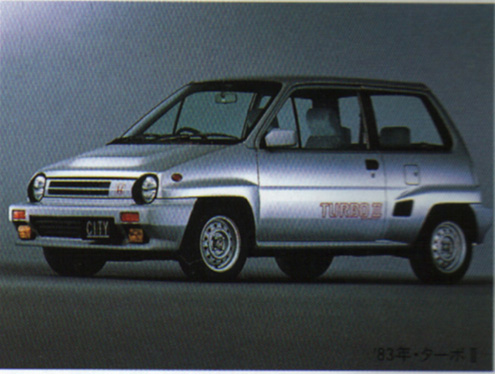
Honda City Turbo
(image from http://asia.vtec.net/scrap/archive1.html)
2. Second Generation (1986-1994)
Quote from Wikipedia:
Honda replaced the original City in 1986 (designated GA1), with an update in 1989 (GA2). This model was produced until 1994. The Fit name also first appeared as a trim variant of the City. There was no convertible model. In most European and Australasian markets, the City’s market position was filled by the Honda Logo in 1999.
Writer’s note: Surprise, surprise, in the said markets, the Honda Logo was then succeeded by none other than the Honda Jazz.
3. Third Generation (1996-2002)
This was the first Honda City sold officially in Malaysia, although it was the third model to bear the name. This car, based on the Civic EF platform, was available in 1.3 and 1.5-litre versions and was designed solely for South-East Asian markets. I hitch rides from my friend to work almost daily in her ‘97 City 1.5 and despite being parked under the hot sun daily, the car seems to be holding together quite well and returns excellent consumption figures.
In 2000, a facelifted version was introduced, with the higher end 1.5-litre versions wearing Type-Z badges and packing VTEC power under their hoods.
4. Fourth Generation (2002 – 2008)
Launched in 2002, the fourth generation City was a major revolution over the previous model. It garnered as much praise for it’s excellent practically and economy as it did with criticisms to its awkward looks. Its curious proportions was due in no small part to it being a sedan derived from the hatchback Jazz. Honda did an excellent job packaging a fantastic interior (in terms of space and design) into a small footprint, but neglected to give the overall look some cohesive proportions.
Initially, the City came only with the 1,497cc SOHC 8-valve engine with Intelligent Dual Sequential Ignition (iDSI). Coupled with a CVT that gives 7 virtual gears in manual shifts, the City offered class-leading fuel economy. In certain markets, it’s even offered with the option of all-wheel drive. But this City’s trump card comes inside. It boasts nearly 500 litres of boot space and comes equipped with the excellent Ultra-Seats, which you can reconfigure in a variety of manners and connect the interior to the already cavernous boot. I heard that with the seats down, you can even slot a mattress in there to.. uhh…. sleep.
Offering all that, and more, Honda’s asking price of RM78.9k (undercutting even the previous City) completely reshaped the market as knew it, placing a Japanese car within striking distance of Proton. It also famously blew Toyota’s pricing strategy completely to bits, as they were ready to launch the Vios priced at RM85k for the 1.5E and RM95k for the 1.5G. To counter the threat of the City, the UMW wisely lowered the asking price of the respective Vios models by RM10k each.
The City VTEC was launched in mid-2004 to attack the Vios 1.5G with a pricetag of RM86k. With VTEC technology and 16 valves, this City is good for 110bhp @ 5,800rpm and 143Nm @ 4,800rpm. It still transmits power to the front wheels via the CVT, but the rear wheels are now stopped by solid disc brakes.
A mid-life facelift came in 2005, where the front end was completely revamped, giving the car a more balanced look. Disappointingly, for this facelift, the designers opted to remove the Ultra-Seats for the VTEC version, a decision that did not sit well with buyers, and was eventually reversed.
I have tested a few units of this City, and I was thoroughly impressed by the space, practicality and build quality of the interior. Despite being a dated model, the City’s interior is still light years ahead of the new Toyota Vios. The VTEC version had great pull, but the iDSI was no slouch either, if one doesn’t expect too much. Unfortunately, the electric power steering (EPS) was overly light and overly assisted, a setup not condusive for more spirited driving.
A known issue with the fourth generation City, at least among Malaysian users, is failure problems of the CVT which costs RM20k to replace – a situation that could really put some owners into a quandary. In most cases, the problem is caused by incorrectly using automatic transmission fluid (ATF) in place of continously variable tranmission fluid (CVTF). However, it is worth noting that certain batches of the City did in fact come from the factory filled with ATF instead of CVTF – a major blunder by Honda.
Nevertheless, the City has found homes in the place of countless car porches. It definitely was great value for money, offering an economical drivetrain (if the CVT doesn’t fail), and a superb interior. It remains a hot seller even now, with the imminent introduction of its successor – which definitely has big shoes to fill.
5. Fifth generation (2008 – )
Coming soon to a showroom near you, the fifth gen City will debut in Malaysia within the next couple of weeks. Honda has developed more variants for this City, with 1.4, 1.5 and 1.8-litre powerplants to couple with either a 5-speed manual, a 5-speed auto or a 6-speed automated manual transmission. However, most of those variants will go to Europe and China as Malaysia makes do with only the 1.5-litre engine coupled with the 5-speed automatic (fingers crossed for the 5M/T).
The 1.5-litre 16-valve SOHC i-VTEC motor produces 120hp @ 6,600rpm and 145Nm @ 4,800rpm, a healthy increase over the outgoing engine, and very close to Proton’s Campro CPS engine. The torque curve shows a dip similar to the famous Campro torque dip, though not as severe, at between 3,300 and 3,500rpm. According to paultan.org, “Honda actually acknowledges this and claims the torque dip provides a smoother drive, whatever that means!” I am glad Proton didn’t use this excuse.
Curiously, however, a couple of areas of the specs sheet has regressed a little, with the omission of the CVT and Ultra-Seat function most notable. Honda claims that 5A/T is better suited for the ASEAN market’s driving style, but that’s definitely only telling half the story. It’s a most unfortunate omission, for the CVT is a wonderful piece of technology. I firmly believe that most of the outgoing City’s CVT failure is due to improper care rather than poor design.
Amusingly, the City’s preview website (link here) trumpets the 60:40 split folding and rear reclining seats as a ‘class achievement’. While the rear reclining seats is a notable feature, it remains a step backwards from the Ultra-Seats as far as I am concerned.
The outgoing City is living some pretty big shoes to fill. Let’s see if the new one is up to the task.
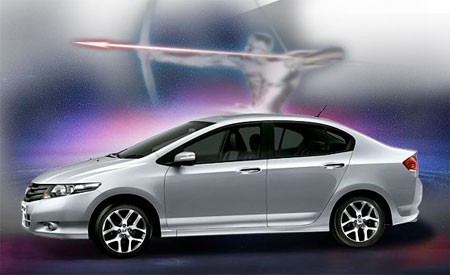
Fifth gen City – coming soon 18 Dec 2008
(image from paultan.org)
Once, it had the Japanese executive car market almost all to itself, then came the world’s largest car company and spoiled the fun.
As the competitor grew ever larger, Honda’s sporting credentials simply could not sway Malaysian buyers who weer besotted with the space.
The latest version to land in Malaysia found its origins in the North American market research results. North Americans like their cars big and they think the version the Europeans get are bit too cramped for them and apparently Malaysians agree. Everything about the car must be viewed from this point of origin.
Honda is, of course, a company that dearly loves motor racing, it competes on two and four wheels at the highest level.
It takes on the best in MotoGP and also in Formula One and thanks to their passion for racing we now have a four-letter acronym that inspires genuine respect and admiration from other carmaker – VTEC.
You wouldn’t expect Honda to go completely soft would you with the new Honda Accord? The truth is they have gone softer but they are keen to point out that the company has not forgotten its motorsports heritage.
Like I said before, the Accord has grown up in size and it now rivals even German luxury sedans when it comes to cabin space and the designers have done a good job reducing its visual bulk without shrinking it’s street presence.
Street presence is the key to selling succesfully in the executive sector and I think Honda has got it just right.
Part of the street presence comes from the bold styling, which incorporates a few adventurous styling tricks such as the use of very strong feature creases near the shoulder line and honlding them up by a deep scallop at the bottom of the doors.
The designers made full use of the strong creases and use to define the rear lamp and allow the use of a highly oversized front lamp clusters. Oversized front lamps is also the in-thing these days.
The large lamps work well with the bright and shiny grille and gives the new Accord a distinctive face, I say distinctive and not pretty because the overall result is highly masculine and has more than just a hint of a technical look. The car is full of complicated lines and surfaces that takes a bit of getting used to.
After a while, the design grew on me and I began to see it as a rather handsome car but I still maintain that it is not a shape that one immediately think as beautiful, unique maybe but certainly not beautiful. Well not on first impression anyway.
From this shot you can see that the designers were going after a powerful stance and used a lot of straight lines and angles to achieve it.
The same play with flat surfaces and straight lines are evident from the rear lamp design which starts with a strong downward swoosh and goes on to harden the rounded corner. The angled rear lamp lens has an aerodynamic purpose. Rounded rear corners causes instability (do you remember the original Audi TT) so engineers put a sharp edge to help the airflow break cleanly from the flanks, this reduces aerodynamic drag and reduces an aero effect called ’slapping’.
As you can see from this angle, the rear design is a bit fussy but I suppose it works because the sharp edges give it a kind of jeweled look that seem to be the flavour of the month.
The powerful look is, part of Honda’s homage to their motorsports heritage and the i-VTEC motor lurking under the bonnet. Thanks to these four letters, Honda has made sure that their very large Accord can still put a smile on a driver’s face
This 2.4-litre four-cylinder can generate nearly 180 horsepower. This is not a mind blowing figure but the engine is silky smooth and the 226 Newton metres of torque is enough to give the car a very relaxed and refined gait.
The engine is so quiet and the cabin so well insulated, you will find yourself revving the engine without even realising it. During my time with the car, I was trying to get as many miles out of the tank as possible by maintaining an artificial redline at 2,500rpm but nothing went as planned because I could not rely on my ears to mark engine speed. I can’t keep looking at the revcounter while driving can I? That’s jsut plain dangerous.
In the end I just enjoyed the power and smoothness of the engine.
Speaking of driver enjoyment, the cabin you get in this car is rather strangely specified. You get cruise control but no fuel economy computer, you get a large LCD screen in the centre console but no centralised know like the I-drive. The large screen shows only air-cond and radio settings, what a waste.
The centre console itself is a neat design and everything is well put together. Even the rows of buttons are laid out in an orderly, in not entirely intuitive fashion.
There are jsut so many buttons you have to give yourself at least a few weeks to remember what function each button controls.
These are minor complaints when you consider that this car feels relatively taut and composed even on twisty roads. The chassis is well judged to give a good balance between ride and handling. While it may not have the directness of the European Accord, this car is still decent fun on state roads and very comfortable on the highway.
The steering is fairly accurate and communicative but it is a rather shy steering, it whispers rather than shouts back feedback. You can’t get a good conversation going between you hand and the steerign because you have to be very gentle on your grip to feel the feedback.
The nice thing is that the car comes with a ready USB connection so you can plug in all your mobile storage devices and enjoy your music and entertainment while on the move.
What I find particularly odd about the centre console layout is the two rotary dials placed at the bottom. One controls the radio volume and the other sets its receiver frequency. Guess which is which.
I thought the large dial should control the volume because size means prominence and prominence usually indicates frequency of use and in my case I change the volume setting more often than radio frequency so I kept reaching for the large dial and suddenly find myself listening to Elvis when I want to do is make Coldplay’s Viva La Vida a bit louder. Annoying.
The Accord is aimed at executives and middle managers who want something big and comfortable for work and the family and this car is right up their alley. The Honda badge has decent street cred and the very modern looks will keep owners happy for at least a few years.
The price tag is RM167,169.80 (OTR without insurance) and that is a highly competitive asking price int his segment.
Where the Accord scores big is in driver satisfaction and this is mainly due to the sharper chassis and the responsive 2.4-litre engine which produces nearly 180 horsepower and 222Nm of torque.













